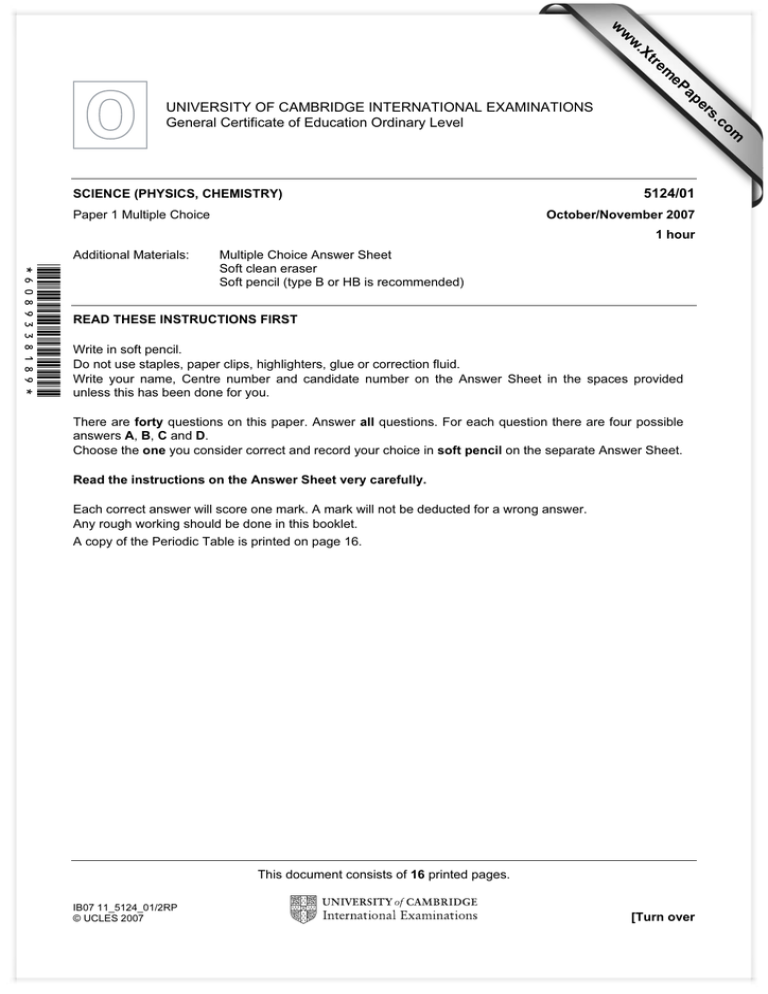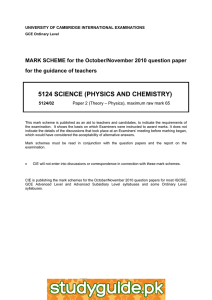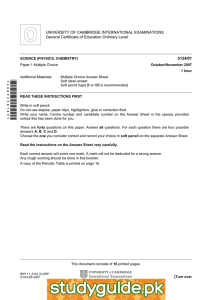www.XtremePapers.com
advertisement

w w om .c s er 5124/01 SCIENCE (PHYSICS, CHEMISTRY) Paper 1 Multiple Choice ap eP m e tr .X w UNIVERSITY OF CAMBRIDGE INTERNATIONAL EXAMINATIONS General Certificate of Education Ordinary Level October/November 2007 1 hour Additional Materials: *6089338189* Multiple Choice Answer Sheet Soft clean eraser Soft pencil (type B or HB is recommended) READ THESE INSTRUCTIONS FIRST Write in soft pencil. Do not use staples, paper clips, highlighters, glue or correction fluid. Write your name, Centre number and candidate number on the Answer Sheet in the spaces provided unless this has been done for you. There are forty questions on this paper. Answer all questions. For each question there are four possible answers A, B, C and D. Choose the one you consider correct and record your choice in soft pencil on the separate Answer Sheet. Read the instructions on the Answer Sheet very carefully. Each correct answer will score one mark. A mark will not be deducted for a wrong answer. Any rough working should be done in this booklet. A copy of the Periodic Table is printed on page 16. This document consists of 16 printed pages. IB07 11_5124_01/2RP © UCLES 2007 [Turn over 2 1 As part of an experiment to find the density of stone, a stone is lowered into a measuring cylinder partly filled with water. final reading (with stone) initial reading (no stone) Which information can be obtained from the measuring cylinder readings? 2 A The difference between the readings gives the density of stone. B The difference between the readings gives the volume of the stone. C The final reading gives the density of stone. D The final reading gives the volume of the stone. When his parachute is fully opened, a parachutist falls towards the ground at a constant speed. Under these conditions, which statement is correct? 3 A There are no forces acting on the parachutist. B The upward force on the parachute is greater than the weight of the parachutist. C The upward force on the parachute is equal to the weight of the parachutist. D The upward force on the parachute is less than the weight of the parachutist. A sledge of mass 25 kg is pulled across level ground with a horizontal force of 60 N. The constant force of friction is 20 N. What is the acceleration of the sledge? A 0.63 m / s2 © UCLES 2007 B 1.6 m / s2 C 2.4 m / s2 5124/01/O/N/07 D 3.2 m / s2 3 4 The diagrams show a spring having a length of 9 cm when loaded with a 100 g mass, and the extension-mass graph for the spring. 3 extension / cm 2 9 cm 1 0 100 g 0 100 200 300 mass / g What is the length of the spring after the 100 g mass has been removed? A 5 6 7 cm B 8 cm C 9 cm D 10 cm Which type of energy is converted to thermal energy when atoms combine? A chemical B kinetic C nuclear D solar A solid metal bar is heated at one end. How is the thermal energy transferred to the other end of the bar? 7 A The heated molecules move along the bar, carrying all their energy to the other end. B The heated molecules move along the bar, giving energy to other molecules as they pass. C The heated molecules stay completely still but pass on their energy to other molecules. D The heated molecules vibrate more rapidly and pass on energy to other molecules. In a liquid-in-glass thermometer, the liquid column is 2.0 cm long at 0 °C and 12.0 cm long at 100 °C. 12.0 cm 2.0 cm 100 °C 0 °C How long will the liquid column be at 30 °C? A 2.3 cm © UCLES 2007 B 3.0 cm C 5.0 cm 5124/01/O/N/07 D 9.0 cm [Turn over 4 8 Equal volumes of four substances are heated at atmospheric pressure. The temperature rise is the same for each substance. Which substance expands the most? 9 A air B mercury C steel D water The diagram shows the surface of the water as a wave passes across a ripple tank. P Q S Which lengths represent the amplitude and wavelength? amplitude wavelength A Q P B Q S C R P D R S 10 A wave has a frequency of 104 Hz. What are the possible values of its velocity and wavelength? velocity in m / s wavelength in m A 330 0.33 B 330 33 C 3 × 108 30 D 3 × 108 3 × 104 © UCLES 2007 5124/01/O/N/07 R 5 11 Which type of electromagnetic radiation travels at the highest speed through a vacuum? A gamma rays B light waves C radio waves D none – all have the same speed 12 A lightning flash carries 25 C of charge and lasts for 0.01 s. What is the current? A 0.0004A B 0.25 A C 25 A D 2500 A 13 A voltmeter is connected across a resistor in an electrical circuit. V What does the reading on the voltmeter measure? A the work done in driving 1 A of current through the resistor B the work done in driving 1 C of charge through the resistor C the work done in driving 1 J of energy through the resistor D the work done in driving 1 W of power through the resistor 14 A 1.0 Ω resistor and a 2.0 Ω resistor are connected in series across a 12 V d.c. supply. What is the current in the circuit? A 12 A B 6.0 A C 4.0 A D 0.25 A 15 The diagram shows some information printed on a light bulb. BE TTERBUY 60 W 240 V Which current is needed to light the bulb at normal brightness? A 0.25 A © UCLES 2007 B 3.0 A C 4.0 A 5124/01/O/N/07 D 15 A [Turn over 6 16 Which diagram shows the correct directions of the magnetic forces on two bar magnets? A S N N S B S N N S C S N N S D S N N S 17 The diagram shows a simple a.c. generator. X Which name is given to part X? A axle B carbon brush C magnet D slip ring © UCLES 2007 5124/01/O/N/07 7 18 How many protons, neutrons and electrons are present in a neutral atom of sodium protons neutrons electrons A 11 12 11 B 11 23 11 C 12 11 12 D 12 23 12 23 11 Na ? 19 The uranium atom 238 92 U emits an alpha-particle to become thorium, which then emits a beta-particle to become protactinium. alpha-particle beta-particle Th thorium Pa protactinium 238 92U uranium What is the proton number (atomic number) of protactinium? A 89 © UCLES 2007 B 90 C 91 5124/01/O/N/07 D 95 [Turn over 8 20 Ra decays with a half-life of 1600 s. Rn decays with a half-life of 52 s. Po decays with a half-life of 9.1 s. Pb decays with a half-life of 10.6 h. The changing count rate for one of these radioactive nuclides is shown in the graph. 70 60 count rate counts per second 50 40 30 20 10 0 0 20 40 60 80 100 time / seconds From the half-life shown by the graph, which was the decaying radioactive nuclide? A Ra © UCLES 2007 B Rn C Po 5124/01/O/N/07 D Pb 120 9 21 Samples of tinned apricots, beans, corn and tomatoes are tested for additives by using chromatography. The chromatograms are compared with those of three artificial additives, P, Q and R. The results are as follows. apricots beans corn tomatoes P Q R artificial additives Which tinned food does not contain any artificial additives? A apricots B beans C corn D tomatoes 22 A substance is in a state in which its particles are widely spaced and able to move freely. It changes to a state in which its particles are in contact but still able to move freely. What is this change called? A condensation B diffusion C evaporation D freezing 23 Element X has proton number 8 and nucleon number 18. Which particles are present in the X2– ion? A 10 electrons, 8 protons, 8 neutrons B 10 electrons, 8 protons, 10 neutrons C 10 electrons, 9 protons, 9 neutrons D 8 electrons, 8 protons, 18 neutrons © UCLES 2007 5124/01/O/N/07 [Turn over 10 24 The table gives the electronic structure of four elements. element electronic structure W 2.7 X 2.8.5 Y 2.8.6 Z 2.8.8.2 Which two elements form an ionic compound? A W and X B C W and Y W and Z D X and Y 25 A molecule of sulphuric acid has the structural formula shown. O O H S O H O How many electrons are involved in forming all the covalent bonds in one molecule? A 6 B 8 C 12 D 16 26 The formula of copper(I) oxide is Cu2O. How many grams of oxygen are combined with 64 g of copper in this compound? A 8 B 16 C 32 27 Which gas is always produced during photosynthesis? A carbon dioxide B methane C oxygen D water vapour © UCLES 2007 5124/01/O/N/07 D 64 11 28 In two separate experiments, the reaction of powdered calcium carbonate with an excess of dilute hydrochloric acid is investigated. The powder used in experiment 1 is finer than that used in experiment 2. All other conditions are identical in both experiments. Which graph shows the results? A B 1 total volume of CO2 / cm3 total volume of CO2 / cm3 2 2 1 0 0 time / s time / s C D 2 total volume of CO2 / cm3 total volume of CO2 / cm3 1 2 1 0 0 time / s time / s 29 Which type of reaction takes place when H+ ions and OH– ions react to form water? A condensation B ionisation C neutralisation D precipitation 30 Which statement about the alkali metals is correct? A Their melting points decrease on descending the group. B Their reactivities decrease on descending the group. C They form covalent bonds with the halogens. D They form oxides on reacting with water. © UCLES 2007 5124/01/O/N/07 [Turn over 12 31 In the experiment shown in the diagram, steam is passed over a heated solid P. Gas Q is collected. P mineral wool saturated with water Q heat water What are substances P and Q? P Q A copper hydrogen B lead oxygen C silver oxygen D zinc hydrogen 32 The diagrams show the electronic structures of four elements. element 1 element 2 element 3 element 4 Which two elements are metals? A 1 and 2 B 1 and 3 C 2 and 4 D 3 and 4 33 Which substance is added to a blast furnace to remove impurities from iron ore? A carbon B limestone C sand D slag © UCLES 2007 5124/01/O/N/07 13 34 Which pollutant is correctly linked to its source? pollutant source A carbon monoxide internal combustion engine B methane volcanoes C nitrogen oxide bacterial decay D sulphur dioxide lightning activity 35 Which gas is used to convert vegetable oils into margarine? A carbon dioxide B hydrogen C nitrogen D oxygen 36 Which statement about the manufacture of ammonia by the Haber Process is correct? A The reactants and product are compounds. B The reactants and product are elements. C The reactants and product are gases. D The reactants are both obtained from the air. 37 Bitumen is obtained from crude oil. What is it used for? A as fuel for aircraft B as fuel for oil stoves C for making polishes D for making roads © UCLES 2007 5124/01/O/N/07 [Turn over 14 38 Which compound decolourises aqueous bromine? H H C A H H C C C B H C H D H H H H H C C C H H H H H H C C C H H H H H C C H H H O H O C O H 39 Compound X has the molecular formula C2H6O. • X can be made by a fermentation process. • X can be oxidised to Y. • X can react with Y to form Z and water. To which homologous series do X, Y and Z belong? X Y Z A alcohols carboxylic acids esters B alcohols esters carboxylic acids C carboxylic acids alcohols esters D carboxylic acids esters alcohols © UCLES 2007 5124/01/O/N/07 15 40 The diagram shows the structure of a monomer. Cl F C H C H Which polymer is made from this monomer? B A Cl F Cl F Cl F Cl F C C C C C C C C Cl F Cl F H H H H D C Cl H Cl H Cl F Cl F C C C C C C C C F H F H H H Cl F Permission to reproduce items where third-party owned material protected by copyright is included has been sought and cleared where possible. Every reasonable effort has been made by the publisher (UCLES) to trace copyright holders, but if any items requiring clearance have unwittingly been included, the publisher will be pleased to make amends at the earliest possible opportunity. © UCLES 2007 5124/01/O/N/07 Magnesium Sodium Calcium 5124/01/O/N/07 Strontium Key b X a b = proton (atomic) number X = atomic symbol a = relative atomic mass *58-71 Lanthanoid series 90-103 Actinoid series Actinium Ac 89 Ra Radium 88 Fr Francium 87 * Hafnium 72 Lanthanum 57 178 Hf 40 Zirconium Zr 91 Titanium 139 Yttrium 22 48 Ti La 39 Y 89 Scandium 21 227 Barium 56 Caesium 45 Sc 226 55 137 Ba 133 Cs 38 Rubidium 37 88 Sr 85 Rb 20 Potassium 19 40 Ca 39 12 24 Mg 23 Na Beryllium 4 Lithium K 11 3 9 Be 7 II Li I 93 Ta 181 Niobium Nb 90 58 73 52 96 Mo W 184 Protactinium Thorium 55 Tc 186 Re 144 Nd 92 60 Uranium U 238 Neodymium 75 Rhenium 43 Technetium 25 Manganese Mn 27 59 28 59 29 64 30 65 5 6 Ru 101 Iron 190 Pm Osmium Os Np 93 Neptunium 61 Promethium 76 44 Ruthenium 26 56 Fe Sm 150 Iridium Pu 94 Plutonium 62 Eu 152 Platinum Am 95 Americium 63 Europium 78 195 Pt Ir 46 Palladium Pd 106 Nickel Ni 192 Samarium 77 45 Rhodium Rh 103 Cobalt Co Gd 157 Gold Au 197 Silver 96 64 Curium Cm Gadolinium 79 47 Ag 108 Copper Cu 201 Bk Terbium Tb 159 Mercury Hg 97 Berkelium 65 80 48 Cadmium Cd 112 Zinc Zn Dy 162 Thallium Tl 204 Indium Cf 98 Californium 66 Es Holmium Ho 165 Lead Pb 207 Tin 99 Einsteinium 67 82 50 119 Sn 115 32 Germanium Ge 73 Silicon In Gallium Dysprosium 81 49 31 70 Ga 14 28 Si Carbon 27 Aluminium 13 12 C Al Boron B 11 7 75 Sb 122 Arsenic As Bi 209 Fermium Fm Erbium Er 167 Bismuth 100 68 83 51 Antimony 33 15 Phosphorus P 31 Nitrogen N 14 8 Se 79 Sulphur Po 169 Md Thulium Tm 101 Mendelevium 69 84 Polonium 52 Tellurium Te 128 Selenium 34 16 S 32 Oxygen O 16 9 Yb 173 Astatine At Iodine I 127 Bromine Br 80 Chlorine No 102 Nobelium 70 Ytterbium 85 53 35 17 Cl 35.5 Fluorine F 19 2 0 Lr Lutetium Lu 175 Radon Rn Xenon Xe 131 Krypton Kr 84 Argon Ar 40 Neon 103 Lawrencium 71 86 54 36 18 10 Ne 20 Helium VII Hydrogen VI 4 V He IV H III 1 The volume of one mole of any gas is 24 dm3 at room temperature and pressure (r.t.p.). 91 Pa Th 232 Praseodymium Cerium 59 141 Pr 140 74 Tungsten 42 Molybdenum 24 Chromium Cr Ce Tantalum 41 23 Vanadium V 51 1 Group DATA SHEET The Periodic Table of the Elements 16 University of Cambridge International Examinations is part of the Cambridge Assessment Group. Cambridge Assessment is the brand name of University of Cambridge Local Examinations Syndicate (UCLES), which is itself a department of the University of Cambridge.





